
Impatiens
Encyclopedia
Impatiens is a genus
of about 850–1,000 species
of flowering plant
s, widely distributed throughout the Northern Hemisphere
and tropics
. Together with the puzzling Hydrocera triflora, this genus makes up the family
Balsaminaceae
. Such a situation is highly unusual, and phylogenetic studies might reveal that Impatiens needs to be split up; some of its species might be closer to Hydrocera than to their presumed congener
s.
Common names include impatiens, jewelweeds, and, somewhat ambiguously, "balsams" and "touch-me-nots". As a rule-of-thumb, "jewelweed" is used exclusively for Nearctic
species, "balsam" is usually applied to tropical species, and "touch-me-not" is typically used in Europe
and North America
. Some species commonly planted in horticulture
have altogether more fanciful names, such as "Busy Lizzie" (the well-known I. walleriana).
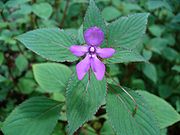 Some species are annual plant
Some species are annual plant
s and produce flowers from early summer until the first frost
, while perennial
species, found in milder climates, can flower all year. Regardless of their lifespan, the largest impatiens grow up to about 2 meters (c. 7 ft) tall, but most are less than half as tall. The leaves are entire and shiny; their upperside has a thick, water-repellent cuticula that gives them a greasy feel. Particularly on the underside of the leaves, tiny air bubbles are trapped under the leaf surface, giving them a silvery sheen that becomes pronounced when held under water. The name "jewelweed" possibly refers to these shiny leaves, particularly obvious after rains when water drops reflect the sunlight like a prism
. However it is more likely that the name is derived from the robin egg blue of the surface of the seed beneath the dark brown aril, or seed coat.
The flowers, up to 2–3 cm, around 1 inch long, in most species are made up by a shoe- or horn-shaped spur for the most part, with at least the upper petal
s insignificant by comparison; some have a prominent labellum
though, allowing pollinator
s to land. Others, like the Busy Lizzie
(I. walleriana), have flattened flowers with large petals and just a tiny spur that appear somewhat similar to violet
s (Viola), though these are unrelated eudicots. A few Impatiens species have flowers quite intermediate between those two basic types.
These plants derives their scientific name Impatiens (Latin
for "impatient") and the common name "touch-me-not" in reference to their seed
capsule
s. When the capsules mature, they "explode" when touched, sending seeds several meters away. This mechanism is also known as "explosive dehiscence"; see also Rapid plant movement
.
; they prefer moist, rich soils, like roadside ditches, reed bed
s, fen
s, river banks
and forest edges, and many are well able to colonize disturbed ruderal locations.
Impatiens foliage is used as food plants by the larva
e of some Lepidoptera
species (e.g. Dot Moth
, Melanchra persicariae), as well as other insect
s, such as the Japanese Beetle
(Popillia japonica). The leaves are toxic to many other animals, including the Budgerigar
(Melopsittacus undulatus), but this popular pet will eat balsam flowers eagerly and as it seems it is not harmed by them. The flowers are visited by bumblebee
s and certain Lepidoptera, such as the Common Spotted Flat (Celaenorrhinus leucocera)
A parasitic plant
using balsams as host is the European Dodder (Cuscuta europea). For plant diseases affecting this genus, see List of impatiens diseases.
 In the 19th and 20th centuries, humans transported the Orange Jewelweed (I. capensis) to England
In the 19th and 20th centuries, humans transported the Orange Jewelweed (I. capensis) to England
, France
, the Netherlands
, Poland
, Sweden
, Finland
, and potentially other areas of Northern
and Central Europe
. For example, it was not recorded from Germany
as recently as 1996, but since then a population seems to have established itself in Hagen
at the Ennepe
river. These naturalized populations persist despite the plant not being grown in gardens on a regular basis. The Orange Jewelweed is quite similar to the Touch-me-not Balsam
(I. noli-tangere) – the only Impatiens species native to Central and Northern Europe – and utilizes similar habitats, but no evidence exists of natural hybrids. Small Balsam (I. parviflora), originally native to southern Central Asia
, is even more extensively naturalized in Europe. More problematic is the Himalayan Balsam
(I. glandulifera), a high-growing species which displaces smaller plants by denying them sunlight. It is an invasive weed in many places, and tends to dominate riparian vegetation along polluted rivers and nitrogen
-rich spots. Thus, it exacerbates ecosystem
degradation by forming stands where few other plants can grow, and by rendering riverbanks more prone to erosion
as it has only a shallow root system.
The starkly differing flower shapes found in this genus, combined with the easy cultivation of many species, have served to make some balsam species model organism
s in plant evolutionary developmental biology
. Also, Impatiens is rather closely related to the carnivorous plant
families
Roridulaceae and Sarraceniaceae
. Peculiar stalked gland
s found on balsam sepal
s secrete mucus
and might be related to the structures from which the prey-catching and -digesting glands of these carnivorous plants evolve
d. Balsams are not known to be protocarnivorous plant
s however.
 Impatiens have become one of the most popular garden annuals. Hybrids, typically derived from "Busy Lizzie" (the well-known I. walleriana) and New Guinea Impatiens (I. hawkeri
Impatiens have become one of the most popular garden annuals. Hybrids, typically derived from "Busy Lizzie" (the well-known I. walleriana) and New Guinea Impatiens (I. hawkeri
), have commercial importance as garden plants with a yearly business volume of about US $230 million. I. walleriana was originally collected from Costa Rica
(where it grows as a weed), and bred through selection by Claude Hope. The original series of impatiens bred by Hope was the 'Elfin' series of cultivar
s, which was subsequently improved as the 'Super Elfin' series. Double-flowered
cultivars also exist. But in tropical islands, such as Hawaiʻi, Busy Lizzie can also become a noxious weed.
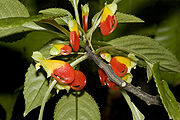 Other Impatiens species, such as I. auricoma
Other Impatiens species, such as I. auricoma
, Garden Balsam (I. balsamina), Blue Diamond Impatiens (I. namchabarwensis), Parrot Flower (I. psittacina), Congo Cockatoo (I. niamniamensis), Ceylon Balsam (I. repens) or Poor Man's Rhododendron (I. sodenii) are also often seen as ornamental plant
s. Note that insecticidal soap
, commonly used against insect pests as it is less harmful to the environment and to most beneficial insects than halocarbon
insecticide
s, is very toxic to some balsams. When controlling insect pests on Impatiens, insecticidal soap should be avoided.
s, and particularly Poison Ivy
(Toxicodendron radicans) and Stinging Nettle
(Urtica dioica) rashes as a folk remedy, despite multiple controlled studies showing it to have no antipruritic
effect.
An oft-repeated folk saying, "Wherever poison ivy is found, jewelweed grows close by", is not true. Poison ivy grows in a wide variety of habitat
s, while jewelweeds are restricted to moist bottomlands and valleys with rich soil. The reverse is often true on the other hand: wherever jewelweed is found, poison ivy is usually close by.
The Orange and the Yellow Jewelweed (I. pallida) have been subject to various scientific studies as regards their alleged effect against Poison Ivy contact dermatitis
. Save for one study conducted in the 1950s, no significant and lasting antipruritic
effect was found compared to other commonly used treatments.
Jewelweed contains 2-methoxy-1-(4-naphtho)quinine, an anti-inflammatory and fungicide that is the active ingredient of Preparation H.
Unspecified Impatiens is one of the traditional 83 Bach flower remedies
, supposedly alleviating impatience, and is contained in the "Rescue Remedy" or "Five Flower Remedy" touted as an anxiolytic
. There is no indication that Bach flower remedies are more effective than a placebo
.
All Impatiens taste bitter and seem to be slightly toxic upon ingestion, causing intestinal ailments like vomiting
and diarrhea
. The toxic compounds have not been identified but are probably the same as those responsible for the bitter taste; they might be glycoside
s or alkaloid
s.
 α-Parinaric acid, a polyunsaturated fatty acid
α-Parinaric acid, a polyunsaturated fatty acid
discovered in the seeds of the Makita Tree (Atuna racemosa), is together with linolenic acid the predominant component of the seed fat of Garden Balsam (I. balsamina), and perhaps other species of Impatiens. This is quite intriguing from a phylogenetic perspective, since the Makita Tree is a member of the Chrysobalanaceae
and belongs to a lineage of eudicots entirely distinct from the balsams.
At least certain jewelweeds and the Garden Balsam contain the naphthoquinone
lawsone
, a dye
that is also found in Henna
(Lawsonia inermis) and responsible for the hair coloring
and skin coloring in mehndi
. In ancient China
, Impatiens petals mashed with rose
and orchid petals and alum
were used as nail polish
: after leaving the mixture on the nails for some hours, it will color them a pink to reddish hue. In Korea, girls and women dye their fingernails overnight with bruised red balsam petals in summer, when balsam flowers are in full bloom. Traditional purpose of fingernail dying was to scare bad spirits, considering that spreading of cholera or any other contagious waterborne diseases were thought to be deeds of bad spirits. Similar to the case of α-Parinaric acid, the henna plant is a Lythraceae
and as such also not closely related to the balsams.
Note that the "balsams" used in shampoo
s (Peru balsam and Tolu balsam
) are derived from the unrelated genus Myroxylon
, as are Canada balsam
(from the Balsam Fir
, Abies balsamea) and Balsam of Mecca
(from Commiphora gileadensis).
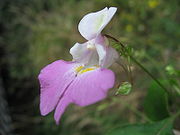
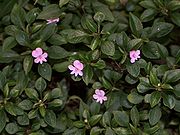
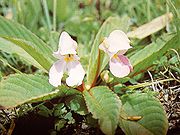
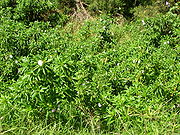
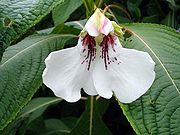
Genus
In biology, a genus is a low-level taxonomic rank used in the biological classification of living and fossil organisms, which is an example of definition by genus and differentia...
of about 850–1,000 species
Species
In biology, a species is one of the basic units of biological classification and a taxonomic rank. A species is often defined as a group of organisms capable of interbreeding and producing fertile offspring. While in many cases this definition is adequate, more precise or differing measures are...
of flowering plant
Flowering plant
The flowering plants , also known as Angiospermae or Magnoliophyta, are the most diverse group of land plants. Angiosperms are seed-producing plants like the gymnosperms and can be distinguished from the gymnosperms by a series of synapomorphies...
s, widely distributed throughout the Northern Hemisphere
Northern Hemisphere
The Northern Hemisphere is the half of a planet that is north of its equator—the word hemisphere literally means “half sphere”. It is also that half of the celestial sphere north of the celestial equator...
and tropics
Tropics
The tropics is a region of the Earth surrounding the Equator. It is limited in latitude by the Tropic of Cancer in the northern hemisphere at approximately N and the Tropic of Capricorn in the southern hemisphere at S; these latitudes correspond to the axial tilt of the Earth...
. Together with the puzzling Hydrocera triflora, this genus makes up the family
Family (biology)
In biological classification, family is* a taxonomic rank. Other well-known ranks are life, domain, kingdom, phylum, class, order, genus, and species, with family fitting between order and genus. As for the other well-known ranks, there is the option of an immediately lower rank, indicated by the...
Balsaminaceae
Balsaminaceae
Balsaminaceae are a family of dicotyledonous plants, comprising two genera and 850+ species, all but one of which belong to the genus Impatiens...
. Such a situation is highly unusual, and phylogenetic studies might reveal that Impatiens needs to be split up; some of its species might be closer to Hydrocera than to their presumed congener
Congenic
In genetics, two organisms that differ in one locus are defined as congenic or coisogenic.-Generating congenic strains:Congenic strains are generated in the laboratory by mating two inbred strains , and backcrossing the descendants 5-10 generations with one of the original strains, known as the...
s.
Common names include impatiens, jewelweeds, and, somewhat ambiguously, "balsams" and "touch-me-nots". As a rule-of-thumb, "jewelweed" is used exclusively for Nearctic
Nearctic
The Nearctic is one of the eight terrestrial ecozones dividing the Earth's land surface.The Nearctic ecozone covers most of North America, including Greenland and the highlands of Mexico...
species, "balsam" is usually applied to tropical species, and "touch-me-not" is typically used in Europe
Europe
Europe is, by convention, one of the world's seven continents. Comprising the westernmost peninsula of Eurasia, Europe is generally 'divided' from Asia to its east by the watershed divides of the Ural and Caucasus Mountains, the Ural River, the Caspian and Black Seas, and the waterways connecting...
and North America
North America
North America is a continent wholly within the Northern Hemisphere and almost wholly within the Western Hemisphere. It is also considered a northern subcontinent of the Americas...
. Some species commonly planted in horticulture
Horticulture
Horticulture is the industry and science of plant cultivation including the process of preparing soil for the planting of seeds, tubers, or cuttings. Horticulturists work and conduct research in the disciplines of plant propagation and cultivation, crop production, plant breeding and genetic...
have altogether more fanciful names, such as "Busy Lizzie" (the well-known I. walleriana).
Description

Annual plant
An annual plant is a plant that usually germinates, flowers, and dies in a year or season. True annuals will only live longer than a year if they are prevented from setting seed...
s and produce flowers from early summer until the first frost
Frost
Frost is the solid deposition of water vapor from saturated air. It is formed when solid surfaces are cooled to below the dew point of the adjacent air as well as below the freezing point of water. Frost crystals' size differ depending on time and water vapour available. Frost is also usually...
, while perennial
Perennial plant
A perennial plant or simply perennial is a plant that lives for more than two years. The term is often used to differentiate a plant from shorter lived annuals and biennials. The term is sometimes misused by commercial gardeners or horticulturalists to describe only herbaceous perennials...
species, found in milder climates, can flower all year. Regardless of their lifespan, the largest impatiens grow up to about 2 meters (c. 7 ft) tall, but most are less than half as tall. The leaves are entire and shiny; their upperside has a thick, water-repellent cuticula that gives them a greasy feel. Particularly on the underside of the leaves, tiny air bubbles are trapped under the leaf surface, giving them a silvery sheen that becomes pronounced when held under water. The name "jewelweed" possibly refers to these shiny leaves, particularly obvious after rains when water drops reflect the sunlight like a prism
Prism (optics)
In optics, a prism is a transparent optical element with flat, polished surfaces that refract light. The exact angles between the surfaces depend on the application. The traditional geometrical shape is that of a triangular prism with a triangular base and rectangular sides, and in colloquial use...
. However it is more likely that the name is derived from the robin egg blue of the surface of the seed beneath the dark brown aril, or seed coat.
The flowers, up to 2–3 cm, around 1 inch long, in most species are made up by a shoe- or horn-shaped spur for the most part, with at least the upper petal
Petal
Petals are modified leaves that surround the reproductive parts of flowers. They often are brightly colored or unusually shaped to attract pollinators. Together, all of the petals of a flower are called a corolla. Petals are usually accompanied by another set of special leaves called sepals lying...
s insignificant by comparison; some have a prominent labellum
Labellum
Labellum is the Latin diminutive of labium, meaning lip. These are anatomical terms used descriptively in biology, for example in Entomology and botany.-Botany:...
though, allowing pollinator
Pollinator
A pollinator is the biotic agent that moves pollen from the male anthers of a flower to the female stigma of a flower to accomplish fertilization or syngamy of the female gamete in the ovule of the flower by the male gamete from the pollen grain...
s to land. Others, like the Busy Lizzie
Busy Lizzie
Impatiens walleriana Hook.f. also known as Busy Lizzy, Balsam or simply Impatiens, is native to eastern Africa from Kenya to Mozambique. It is a herbaceous perennial plant growing to 15-60 cm tall, with broad lanceolate leaves 3-12 cm long and 2-5 cm broad...
(I. walleriana), have flattened flowers with large petals and just a tiny spur that appear somewhat similar to violet
Violet (plant)
Viola is a genus of flowering plants in the violet family Violaceae, with around 400–500 species distributed around the world. Most species are found in the temperate Northern Hemisphere; however, viola species are also found in widely divergent areas such as Hawaii, Australasia, and the Andes in...
s (Viola), though these are unrelated eudicots. A few Impatiens species have flowers quite intermediate between those two basic types.
These plants derives their scientific name Impatiens (Latin
Latin
Latin is an Italic language originally spoken in Latium and Ancient Rome. It, along with most European languages, is a descendant of the ancient Proto-Indo-European language. Although it is considered a dead language, a number of scholars and members of the Christian clergy speak it fluently, and...
for "impatient") and the common name "touch-me-not" in reference to their seed
Seed
A seed is a small embryonic plant enclosed in a covering called the seed coat, usually with some stored food. It is the product of the ripened ovule of gymnosperm and angiosperm plants which occurs after fertilization and some growth within the mother plant...
capsule
Capsule (fruit)
In botany a capsule is a type of simple, dry fruit produced by many species of flowering plants. A capsule is a structure composed of two or more carpels that in most cases is dehiscent, i.e. at maturity, it splits apart to release the seeds within. A few capsules are indehiscent, for example...
s. When the capsules mature, they "explode" when touched, sending seeds several meters away. This mechanism is also known as "explosive dehiscence"; see also Rapid plant movement
Rapid plant movement
Rapid plant movement encompasses movement in plant structures occurring over a very short period of time, usually under one second. For example, the Venus Flytrap closes its trap in about 100 milliseconds. The Dogwood Bunchberry's flower opens its petals and fires pollen in less than 0.5 milliseconds...
.
Ecology and uses
Balsams grow both in and out of direct sunlightSunlight
Sunlight, in the broad sense, is the total frequency spectrum of electromagnetic radiation given off by the Sun. On Earth, sunlight is filtered through the Earth's atmosphere, and solar radiation is obvious as daylight when the Sun is above the horizon.When the direct solar radiation is not blocked...
; they prefer moist, rich soils, like roadside ditches, reed bed
Reed bed
Reed beds are natural habitats found in floodplains, waterlogged depressions andestuaries. Reed beds are part of a succession from young reed colonising open water or wet ground through a gradation of increasingly dry ground...
s, fen
Fen
A fen is a type of wetland fed by mineral-rich surface water or groundwater. Fens are characterised by their water chemistry, which is neutral or alkaline, with relatively high dissolved mineral levels but few other plant nutrients...
s, river banks
Bank (geography)
A geographic bank has four definitions and applications:# Limnology: The shoreline of a pond, swamp, estuary, reservoir, or lake. The grade can vary from vertical to a shallow slope....
and forest edges, and many are well able to colonize disturbed ruderal locations.
Impatiens foliage is used as food plants by the larva
Larva
A larva is a distinct juvenile form many animals undergo before metamorphosis into adults. Animals with indirect development such as insects, amphibians, or cnidarians typically have a larval phase of their life cycle...
e of some Lepidoptera
Lepidoptera
Lepidoptera is a large order of insects that includes moths and butterflies . It is one of the most widespread and widely recognizable insect orders in the world, encompassing moths and the three superfamilies of butterflies, skipper butterflies, and moth-butterflies...
species (e.g. Dot Moth
Dot Moth
The Dot Moth is a moth of the family Noctuidae. It is found throughout Europe apart from the south-east.This is a very distinctive species with very dark brown, almost black, forewings marked with a large white stigma from which the species gets its common name. The hindwings are grey with a dark...
, Melanchra persicariae), as well as other insect
Insect
Insects are a class of living creatures within the arthropods that have a chitinous exoskeleton, a three-part body , three pairs of jointed legs, compound eyes, and two antennae...
s, such as the Japanese Beetle
Japanese beetle
The beetle species Popillia japonica is commonly known as the Japanese beetle. It is about long and wide, with iridescent copper-colored elytra and green thorax and head...
(Popillia japonica). The leaves are toxic to many other animals, including the Budgerigar
Budgerigar
The Budgerigar , also known as Common Pet Parakeet or Shell Parakeet informally nicknamed the budgie, is a small, long-tailed, seed-eating parrot, and the only species in the Australian genus Melopsittacus...
(Melopsittacus undulatus), but this popular pet will eat balsam flowers eagerly and as it seems it is not harmed by them. The flowers are visited by bumblebee
Bumblebee
A bumble bee is any member of the bee genus Bombus, in the family Apidae. There are over 250 known species, existing primarily in the Northern Hemisphere although they are common in New Zealand and in the Australian state of Tasmania.Bumble bees are social insects that are characterised by black...
s and certain Lepidoptera, such as the Common Spotted Flat (Celaenorrhinus leucocera)
A parasitic plant
Parasitic plant
A parasitic plant is one that derives some or all of its sustenance from another plant. About 4,100 species in approximately 19 families of flowering plants are known. Parasitic plants have a modified root, the haustorium, that penetrates the host plant and connects to the xylem, phloem, or...
using balsams as host is the European Dodder (Cuscuta europea). For plant diseases affecting this genus, see List of impatiens diseases.

England
England is a country that is part of the United Kingdom. It shares land borders with Scotland to the north and Wales to the west; the Irish Sea is to the north west, the Celtic Sea to the south west, with the North Sea to the east and the English Channel to the south separating it from continental...
, France
France
The French Republic , The French Republic , The French Republic , (commonly known as France , is a unitary semi-presidential republic in Western Europe with several overseas territories and islands located on other continents and in the Indian, Pacific, and Atlantic oceans. Metropolitan France...
, the Netherlands
Netherlands
The Netherlands is a constituent country of the Kingdom of the Netherlands, located mainly in North-West Europe and with several islands in the Caribbean. Mainland Netherlands borders the North Sea to the north and west, Belgium to the south, and Germany to the east, and shares maritime borders...
, Poland
Poland
Poland , officially the Republic of Poland , is a country in Central Europe bordered by Germany to the west; the Czech Republic and Slovakia to the south; Ukraine, Belarus and Lithuania to the east; and the Baltic Sea and Kaliningrad Oblast, a Russian exclave, to the north...
, Sweden
Sweden
Sweden , officially the Kingdom of Sweden , is a Nordic country on the Scandinavian Peninsula in Northern Europe. Sweden borders with Norway and Finland and is connected to Denmark by a bridge-tunnel across the Öresund....
, Finland
Finland
Finland , officially the Republic of Finland, is a Nordic country situated in the Fennoscandian region of Northern Europe. It is bordered by Sweden in the west, Norway in the north and Russia in the east, while Estonia lies to its south across the Gulf of Finland.Around 5.4 million people reside...
, and potentially other areas of Northern
Northern Europe
Northern Europe is the northern part or region of Europe. Northern Europe typically refers to the seven countries in the northern part of the European subcontinent which includes Denmark, Estonia, Latvia, Lithuania, Norway, Finland and Sweden...
and Central Europe
Central Europe
Central Europe or alternatively Middle Europe is a region of the European continent lying between the variously defined areas of Eastern and Western Europe...
. For example, it was not recorded from Germany
Germany
Germany , officially the Federal Republic of Germany , is a federal parliamentary republic in Europe. The country consists of 16 states while the capital and largest city is Berlin. Germany covers an area of 357,021 km2 and has a largely temperate seasonal climate...
as recently as 1996, but since then a population seems to have established itself in Hagen
Hagen
Hagen is the 39th-largest city in Germany, located in the federal state of North Rhine-Westphalia. It is located on the eastern edge of the Ruhr area, 15 km south of Dortmund, where the rivers Lenne, Volme and Ennepe meet the river Ruhr...
at the Ennepe
Ennepe
The Ennepe is a river and a left tributary of the Volme in Northern Sauerland.-Riverflow:The Ennepe begins in the Märkischer Kreis southeast of Halver at 425 m above sea level and continues to Ennepetalsperre . The river flows through Gevelsberg and western Hagen-Haspe and then into Hagen into...
river. These naturalized populations persist despite the plant not being grown in gardens on a regular basis. The Orange Jewelweed is quite similar to the Touch-me-not Balsam
Touch-me-not Balsam
Impatiens noli-tangere is an annual herbaceous plant in the family Balsaminaceae found in damp places in Europe, Asia and North America...
(I. noli-tangere) – the only Impatiens species native to Central and Northern Europe – and utilizes similar habitats, but no evidence exists of natural hybrids. Small Balsam (I. parviflora), originally native to southern Central Asia
Central Asia
Central Asia is a core region of the Asian continent from the Caspian Sea in the west, China in the east, Afghanistan in the south, and Russia in the north...
, is even more extensively naturalized in Europe. More problematic is the Himalayan Balsam
Himalayan Balsam
Impatiens glandulifera is a large annual plant native to the Himalayas. Via human introduction it is now extant across much of the Northern Hemisphere.-Etymology:...
(I. glandulifera), a high-growing species which displaces smaller plants by denying them sunlight. It is an invasive weed in many places, and tends to dominate riparian vegetation along polluted rivers and nitrogen
Nitrogen
Nitrogen is a chemical element that has the symbol N, atomic number of 7 and atomic mass 14.00674 u. Elemental nitrogen is a colorless, odorless, tasteless, and mostly inert diatomic gas at standard conditions, constituting 78.08% by volume of Earth's atmosphere...
-rich spots. Thus, it exacerbates ecosystem
Ecosystem
An ecosystem is a biological environment consisting of all the organisms living in a particular area, as well as all the nonliving , physical components of the environment with which the organisms interact, such as air, soil, water and sunlight....
degradation by forming stands where few other plants can grow, and by rendering riverbanks more prone to erosion
Erosion
Erosion is when materials are removed from the surface and changed into something else. It only works by hydraulic actions and transport of solids in the natural environment, and leads to the deposition of these materials elsewhere...
as it has only a shallow root system.
The starkly differing flower shapes found in this genus, combined with the easy cultivation of many species, have served to make some balsam species model organism
Model organism
A model organism is a non-human species that is extensively studied to understand particular biological phenomena, with the expectation that discoveries made in the organism model will provide insight into the workings of other organisms. Model organisms are in vivo models and are widely used to...
s in plant evolutionary developmental biology
Plant evolutionary developmental biology
Evolutionary developmental biology refers to the study of developmental programs and patterns from an evolutionary perspective. It seeks to understand the various influences shaping the form and nature of life on the planet. Evo-devo arose as a separate branch of science rather recently. An early...
. Also, Impatiens is rather closely related to the carnivorous plant
Carnivorous plant
Carnivorous plants are plants that derive some or most of their nutrients from trapping and consuming animals or protozoans, typically insects and other arthropods. Carnivorous plants appear adapted to grow in places where the soil is thin or poor in nutrients, especially nitrogen, such as acidic...
families
Family (biology)
In biological classification, family is* a taxonomic rank. Other well-known ranks are life, domain, kingdom, phylum, class, order, genus, and species, with family fitting between order and genus. As for the other well-known ranks, there is the option of an immediately lower rank, indicated by the...
Roridulaceae and Sarraceniaceae
Sarraceniaceae
Sarraceniaceae is a family of pitcher plants , belonging to order Ericales .The family comprises three extant genera: Sarracenia , Darlingtonia , and Heliamphora . The extinct Archaeamphora longicervia may also belong to this family...
. Peculiar stalked gland
Gland (botany)
In plants, a gland is defined functionally as a plant structure which secretes one or more products. This may be located on or near the plant surface and secrete externally, or be internal to the plant and secrete into a canal or reservoir...
s found on balsam sepal
Sepal
A sepal is a part of the flower of angiosperms . Collectively the sepals form the calyx, which is the outermost whorl of parts that form a flower. Usually green, sepals have the typical function of protecting the petals when the flower is in bud...
s secrete mucus
Mucus
In vertebrates, mucus is a slippery secretion produced by, and covering, mucous membranes. Mucous fluid is typically produced from mucous cells found in mucous glands. Mucous cells secrete products that are rich in glycoproteins and water. Mucous fluid may also originate from mixed glands, which...
and might be related to the structures from which the prey-catching and -digesting glands of these carnivorous plants evolve
Evolution
Evolution is any change across successive generations in the heritable characteristics of biological populations. Evolutionary processes give rise to diversity at every level of biological organisation, including species, individual organisms and molecules such as DNA and proteins.Life on Earth...
d. Balsams are not known to be protocarnivorous plant
Protocarnivorous plant
A protocarnivorous plant , according to some definitions, traps and kills insects or other animals but lacks the ability to either directly digest or absorb nutrients from its prey like a carnivorous plant...
s however.
Cultivation

Impatiens hawkeri
Impatiens hawkeri is a New Guinea Impatiens species that is one of the sources for the popular New Guinea hybrid impatiens. It was the first of the New Guinea species, collected in Papua in 1884 by Lt. Hawker R. N. It was popular in the 19th century as a greenhouse plant...
), have commercial importance as garden plants with a yearly business volume of about US $230 million. I. walleriana was originally collected from Costa Rica
Costa Rica
Costa Rica , officially the Republic of Costa Rica is a multilingual, multiethnic and multicultural country in Central America, bordered by Nicaragua to the north, Panama to the southeast, the Pacific Ocean to the west and the Caribbean Sea to the east....
(where it grows as a weed), and bred through selection by Claude Hope. The original series of impatiens bred by Hope was the 'Elfin' series of cultivar
Cultivar
A cultivar'Cultivar has two meanings as explained under Formal definition. When used in reference to a taxon, the word does not apply to an individual plant but to all those plants sharing the unique characteristics that define the cultivar. is a plant or group of plants selected for desirable...
s, which was subsequently improved as the 'Super Elfin' series. Double-flowered
Double-flowered
"Double-flowered" describes varieties of flowers with extra petals, often containing flowers within flowers. The double-flowered trait is often noted alongside the scientific name with the abbreviation fl. pl....
cultivars also exist. But in tropical islands, such as Hawaiʻi, Busy Lizzie can also become a noxious weed.

Impatiens auricoma
Impatiens auricoma is a species of perennial flowering plant often grown in temperate climates as an annual....
, Garden Balsam (I. balsamina), Blue Diamond Impatiens (I. namchabarwensis), Parrot Flower (I. psittacina), Congo Cockatoo (I. niamniamensis), Ceylon Balsam (I. repens) or Poor Man's Rhododendron (I. sodenii) are also often seen as ornamental plant
Ornamental plant
Ornamental plants are plants that are grown for decorative purposes in gardens and landscape design projects, as house plants, for cut flowers and specimen display...
s. Note that insecticidal soap
Insecticidal soap
Insecticidal soap is defined as any of the potassium fatty acid soaps used to control many plant pests. Insecticidal soap is typically sprayed on plants in the same manner as other insecticides. Insecticidal soap works only on direct contact with the pests. The fatty acids disrupt the structure and...
, commonly used against insect pests as it is less harmful to the environment and to most beneficial insects than halocarbon
Halocarbon
Halocarbon compounds are chemicals in which one or more carbon atoms are linked by covalent bonds with one or more halogen atoms resulting in the formation of organofluorine compounds, organochlorine compounds, organobromine compounds, and organoiodine compounds...
insecticide
Insecticide
An insecticide is a pesticide used against insects. They include ovicides and larvicides used against the eggs and larvae of insects respectively. Insecticides are used in agriculture, medicine, industry and the household. The use of insecticides is believed to be one of the major factors behind...
s, is very toxic to some balsams. When controlling insect pests on Impatiens, insecticidal soap should be avoided.
Medical significance and phytochemistry
The North American jewelweeds are often used as a home remedy to treat bee stings, insect biteInsect bite
Insect bites and stings occur when an insect is agitated and seeks to defend itself through its natural defense mechanisms, or when an insect seeks to feed off the bitten person. Some insects inject formic acid, which can cause an immediate skin reaction often resulting in redness and swelling in...
s, and particularly Poison Ivy
Poison Ivy
Poison Ivy is a fictional character, a DC Comics supervillainess who is primarily an enemy of Batman. Created by Robert Kanigher and Sheldon Moldoff, she first appeared in Batman #181 ....
(Toxicodendron radicans) and Stinging Nettle
Stinging nettle
Stinging nettle or common nettle, Urtica dioica, is a herbaceous perennial flowering plant, native to Europe, Asia, northern Africa, and North America, and is the best-known member of the nettle genus Urtica...
(Urtica dioica) rashes as a folk remedy, despite multiple controlled studies showing it to have no antipruritic
Antipruritic
Antipruritics, also known as anti-itch drugs, are medications that inhibit the itching that is often associated with sunburns, allergic reactions, eczema, psoriasis, chickenpox, fungal infections, insect bites and stings like those from mosquitoes, fleas, and mites, and contact dermatitis and...
effect.
An oft-repeated folk saying, "Wherever poison ivy is found, jewelweed grows close by", is not true. Poison ivy grows in a wide variety of habitat
Habitat
* Habitat , a place where a species lives and grows*Human habitat, a place where humans live, work or play** Space habitat, a space station intended as a permanent settlement...
s, while jewelweeds are restricted to moist bottomlands and valleys with rich soil. The reverse is often true on the other hand: wherever jewelweed is found, poison ivy is usually close by.
The Orange and the Yellow Jewelweed (I. pallida) have been subject to various scientific studies as regards their alleged effect against Poison Ivy contact dermatitis
Contact dermatitis
Contact dermatitis is a term for a skin reaction resulting from exposure to allergens or irritants . Phototoxic dermatitis occurs when the allergen or irritant is activated by sunlight....
. Save for one study conducted in the 1950s, no significant and lasting antipruritic
Antipruritic
Antipruritics, also known as anti-itch drugs, are medications that inhibit the itching that is often associated with sunburns, allergic reactions, eczema, psoriasis, chickenpox, fungal infections, insect bites and stings like those from mosquitoes, fleas, and mites, and contact dermatitis and...
effect was found compared to other commonly used treatments.
Jewelweed contains 2-methoxy-1-(4-naphtho)quinine, an anti-inflammatory and fungicide that is the active ingredient of Preparation H.
Unspecified Impatiens is one of the traditional 83 Bach flower remedies
Bach flower remedies
Bach flower remedies are dilutions of flower material developed by Edward Bach, an English bacteriologist, pathologist and homeopath, in the 1930s. Bach believed that dew found on flower petals retain healing properties of that plant...
, supposedly alleviating impatience, and is contained in the "Rescue Remedy" or "Five Flower Remedy" touted as an anxiolytic
Anxiolytic
An anxiolytic is a drug used for the treatment of anxiety, and its related psychological and physical symptoms...
. There is no indication that Bach flower remedies are more effective than a placebo
Placebo
A placebo is a simulated or otherwise medically ineffectual treatment for a disease or other medical condition intended to deceive the recipient...
.
All Impatiens taste bitter and seem to be slightly toxic upon ingestion, causing intestinal ailments like vomiting
Vomiting
Vomiting is the forceful expulsion of the contents of one's stomach through the mouth and sometimes the nose...
and diarrhea
Diarrhea
Diarrhea , also spelled diarrhoea, is the condition of having three or more loose or liquid bowel movements per day. It is a common cause of death in developing countries and the second most common cause of infant deaths worldwide. The loss of fluids through diarrhea can cause dehydration and...
. The toxic compounds have not been identified but are probably the same as those responsible for the bitter taste; they might be glycoside
Glycoside
In chemistry, a glycoside is a molecule in which a sugar is bound to a non-carbohydrate moiety, usually a small organic molecule. Glycosides play numerous important roles in living organisms. Many plants store chemicals in the form of inactive glycosides. These can be activated by enzyme...
s or alkaloid
Alkaloid
Alkaloids are a group of naturally occurring chemical compounds that contain mostly basic nitrogen atoms. This group also includes some related compounds with neutral and even weakly acidic properties. Also some synthetic compounds of similar structure are attributed to alkaloids...
s.

Polyunsaturated fatty acid
Polyunsaturated fatty acids are fatty acids that contain more than one double bond in their backbone. This class includes many important compounds, such as essential fatty acids and those that give drying oils their characteristic property....
discovered in the seeds of the Makita Tree (Atuna racemosa), is together with linolenic acid the predominant component of the seed fat of Garden Balsam (I. balsamina), and perhaps other species of Impatiens. This is quite intriguing from a phylogenetic perspective, since the Makita Tree is a member of the Chrysobalanaceae
Chrysobalanaceae
Chrysobalanaceae is a family of trees, shrubs and flowering plants, consisting of 17 genera and about 460 species of leptocaul that grows in the Tropics or is subtropical and common in the Americas...
and belongs to a lineage of eudicots entirely distinct from the balsams.
At least certain jewelweeds and the Garden Balsam contain the naphthoquinone
Naphthoquinone
Naphthoquinone is a class of natural phenols based on the C6-C4 skeleton.1,4-Naphthoquinone can be viewed as derivatives of naphthalene through the replacement of two hydrogen atoms by two ketone groups....
lawsone
Lawsone
Lawsone , also known as hennotannic acid, is a red-orange dye present in the leaves of the henna plant as well as jewelweed . Humans have used henna extracts containing lawsone as hair and skin pigments for more than 5000 years...
, a dye
Dye
A dye is a colored substance that has an affinity to the substrate to which it is being applied. The dye is generally applied in an aqueous solution, and requires a mordant to improve the fastness of the dye on the fiber....
that is also found in Henna
Henna
Henna is a flowering plant used since antiquity to dye skin, hair, fingernails, leather and wool. The name is also used for dye preparations derived from the plant, and for the art of temporary tattooing based on those dyes...
(Lawsonia inermis) and responsible for the hair coloring
Hair coloring
Hair coloring is the practice of changing the color of hair. Common reasons are to cover gray hair, to change to a color regarded as more fashionable or desirable, and to restore the original hair color after it has been discolored by hairdressing processes or sun bleaching...
and skin coloring in mehndi
Mehndi
Mehndi or menhdi is the application of henna as a temporary form of skin decoration in India, as well as by expatriate communities from the country. The word mehndi is derived from the Sanskrit word mendhikā. The use of mehndi and turmeric is described in the earliest Vedic ritual books...
. In ancient China
China
Chinese civilization may refer to:* China for more general discussion of the country.* Chinese culture* Greater China, the transnational community of ethnic Chinese.* History of China* Sinosphere, the area historically affected by Chinese culture...
, Impatiens petals mashed with rose
Rose
A rose is a woody perennial of the genus Rosa, within the family Rosaceae. There are over 100 species. They form a group of erect shrubs, and climbing or trailing plants, with stems that are often armed with sharp prickles. Flowers are large and showy, in colours ranging from white through yellows...
and orchid petals and alum
Alum
Alum is both a specific chemical compound and a class of chemical compounds. The specific compound is the hydrated potassium aluminium sulfate with the formula KAl2.12H2O. The wider class of compounds known as alums have the related empirical formula, AB2.12H2O.-Chemical properties:Alums are...
were used as nail polish
Nail polish
Nail polish, or nail varnish, is a lacquer applied to human fingernails or toenails to decorate and/or protect the nail plate.-History:...
: after leaving the mixture on the nails for some hours, it will color them a pink to reddish hue. In Korea, girls and women dye their fingernails overnight with bruised red balsam petals in summer, when balsam flowers are in full bloom. Traditional purpose of fingernail dying was to scare bad spirits, considering that spreading of cholera or any other contagious waterborne diseases were thought to be deeds of bad spirits. Similar to the case of α-Parinaric acid, the henna plant is a Lythraceae
Lythraceae
Lythraceae are a family of flowering plants. It includes about 620 species of mostly herbs, with some shrubs and trees, in 31 genera. Major genera include Cuphea , Lagerstroemia , Nesaea , Rotala , and Lythrum...
and as such also not closely related to the balsams.
Note that the "balsams" used in shampoo
Shampoo
Shampoo is a hair care product used for the removal of oils, dirt, skin particles, dandruff, environmental pollutants and other contaminant particles that gradually build up in hair...
s (Peru balsam and Tolu balsam
Tolu balsam
Tolu balsam or balsam of Tolu is the resinous secretion of Myroxylon balsamum.The resin is still used in certain cough syrup formulas. However its main use in the modern era is in perfumery, where it is valued for its warm, mellow yet somewhat spicy scent. It is also used as a natural remedy for...
) are derived from the unrelated genus Myroxylon
Myroxylon
Myroxylon J.R.Forst. & G.Forst is a synonym of Xylosma.Myroxylon is a genus of two species of Central American and South American trees in the Fabaceae . The tree is well known in the western world as the source for Peru balsam and Tolu balsam. The tree is often called Quina or Balsamo...
, as are Canada balsam
Canada balsam
Canada balsam, also called Canada turpentine or balsam of fir, is a turpentine which is made from the resin of the balsam fir tree of boreal North America...
(from the Balsam Fir
Balsam Fir
The balsam fir is a North American fir, native to most of eastern and central Canada and the northeastern United States .-Growth:It is a small to medium-size evergreen tree typically tall, rarely to tall, with a narrow conic crown...
, Abies balsamea) and Balsam of Mecca
Balsam of Mecca
Balsam of Mecca is a resinous gum of the tree Commiphora gileadensis , native to southern Arabia and also naturalized, in ancient and again in modern times, in ancient Judea/Palestine/Israel. The most famous site of balsam production in the region was the Jewish town of Ein Gedi...
(from Commiphora gileadensis).
Selected species





External links
- ABC Impatiens
- Flora of China: Impatiens species list
- Flora Europaea: Impatiens
- Flora of Madagascar: Impatiens species list
- GardenWeb Impatiens Forum
- Identifying and harvesting edible and medicinal plants in wild (and not-so-wild) places
- the vibrant world of Busy Lizzies, Balsams, and Touch-me-nots
- Jewelweed image
- UK National Plant Collection of Impatiens

